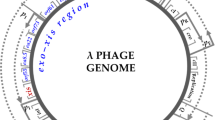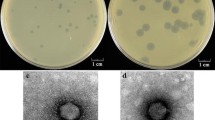Summary
The nucleotide sequence of the 3.4 kb SphI-G fragment that contained the repressor gene (c) of the temperate Streptomyces phage ϕc31 was determined. Analysis of this sequence revealed a large open reading frame with protein coding character and sequence changes in c gene point and deletion mutants identified this as the coding region of the repressor. Two of the mutants studied had undergone deletions of 1.1 kb and 1.4 kb that had occurred across short direct repeats of 6 bp and 11 bp, respectively. Coupled in vitro transcription-translation experiments using the cloned SphI-G fragment and Streptomyces lividans cell free extracts identified a protein product of approximately 72 kDa, in close agreement with that predicted from the nucleotide sequence. A strongly predicted helix-turn-helix motif that may be involved in DNA binding occurred towards the carboxy-terminus of the amino acid sequence. Initial attempts to clone the SphI-G fragment in Streptomyces failed; using information gained from the sequence analysis a smaller segment of this DNA fragment was cloned in S. lividans and conferred immunity to a clear plaque mutant (c1) of ϕc31.
Similar content being viewed by others

References
Albertini AM, Hofer M, Calos MP, Miller JH (1982) On the formation of spontaneous deletions: The importance of short sequence homologies in the generation of large deletions. Cell 29:319–328
Bankier AT, Barrell BG (1983) Shotgun DNA sequencing. In: Flavell RA (ed) Techniques in the life sciences. Elsevier, Ireland, pp 1–34
Benigni R, Antonov P, Carere A (1975) Estimate of the genome size by renaturation studies in Streptomyces. Appl Microbiol 30:324–326
Bibb MJ, Schottel JL, Cohen SN (1980) A DNA cloning system for interspecific gene transfer in antibiotic producing Streptomyces. Nature 274:526–531
Bibb MJ, Findlay PR, Johnson MW (1984) The relationship between base composition and codon-usage in bacterial genes and its use for the simple and reliable identification of protein coding sequences. Gene 30:157–166
Brendel V, Trifonov EN (1984) A computer algorithm for testing potential prokaryotic terminators. Nucleic Acids Res 12:4411–4427
Chater KF (1986) Streptomyces phages and their application to Streptomyces genetics. In: Queener SE, Day LE (eds) The Bacteria vol. IX, Antibiotic producing Streptomyces. Academic Press, London, pp 119–158
Cole ST, Raibaud O (1986) The nucleotide sequence of the malT gene encoding the positive regulator of the Escherichia coli maltose region. Gene 42:201–208
Dayhoff MO, Schwartz RM, Orcutt BC (1982) A model of evolutionary change in proteins. Atlas Protein Sequence Structure 5:345–362
Efstratiadis A, Posakony JW, Maniatis T, Lawn RM, O'Connell C, Spritz RA, DeRiel JK, Forget BG, Weissman SM, Slighton JL, Blechl AE, Smithies O, Baralle FE, Shoulders CC, Proudfoot NJ (1980) The structure and evolution of the human β globin gene family. Cell 21:653–668
Farabaugh PJ, Schmeisser U, Hofer M, Miller JH (1978) Genetic studies of the lac repressor VII—on the molecular nature of spontaneous hotspots in the lacI gene of Escherichia coli. J Mol Biol 126:847–857
Fiers W, Grosjean H (1979) On codon usage. Nature 277:328–328
Frank R, Muller D, Wolff C (1981) Identification and suppression of secondary structures formed from deoxy-oligonucleotides during electrophoresis in denaturing polyacrylamide gels. Nucleic Acids Res 9:4967–4979
Genthner FJ, Hook LA, Strohl WR (1985) Determination of the molecular mass of bacterial genomic DNA and plasmid copy number by high pressure liquid chromatography. Appl Environ Microbiol 50:1007–1013
Gribskov M, Devereux J, Burgess RR (1984) The codon-preference plot: Graphic analysis of protein sequences and prediction of gene expression. Nucleic Acids Res 12:539–549
Grosjean H, Fiers W (1982) Preferential codon-usage in prokaryotic genes: The optimal codon-anticodon interaction energy and the selective codon-usage in efficiently expressed genes. Cell 18:199–209
Hanahan D (1983) Studies on transformation of E. coli with plasmids. J Mol Biol 166:557–580
Harris JE, Chater KF, Bruton CJ, Piret JM (1983) The restriction mapping of c gene deletions in Streptomyces bacteriophage ϕc31 and their use in cloning vector development. Gene 22:167–174
Henikoff S (1984) Unidirectional digestion with exonuclease III creates targeted breakpoints for DNA sequencing. Gene 28:351–359
Ho Y-S, Wolff D, Rosenberg M (1986) Protein-nucleic acid interactions involved in transcriptional activation by the phage lambda regulatory protein CII. In: Booth IR, Higgins CF (eds) Regulation of gene expression—25 years on, 39th Symposium of the Society for General Microbiology. Cambridge University Press, Cambridge, pp 79–103
Hopwood DA, Kieser T, Wright HM, Bibb MJ (1983) Plasmids, recombination and chromosome mapping in Streptomyces lividans 66. Plasmid 11:1–16
Hopwood DA, Bibb MJ, Chater KF, Kieser T, Bruton CJ, Kieser HM, Lydiate DJ, Smith CP, Ward JM, Schrempf H (1985) Genetic manipulation of Streptomyces: A laboratory manual. The John Innes Foundation, Norwich
Ish-Horowitz D, Burke JF (1981) Rapid and efficient cosmid cloning. Nucleic Acids Res 9:2989–1998
Katz E, Thompson CJ, Hopwood DA (1983) Cloning and expression of the tyrosinase gene from Streptomyces antibioticus in Streptomyces lividans. J Gen Microbiol 129:2703–2714
Laemmli UK (1970) Cleavage of structural proteins during the assembly of the head of bacteriophage T4. Nature 227:680–685
Lipman DJ, Pearson WR (1985) Rapid and sensitive protein similarity searches. Science 227:1435–1441
Lomovskaya ND, Mkrtumian NM, Gotimskaya NL, Danilenko VN (1972) Characterisation of temperate actinophage ϕc31 isolated from Streptomyces coelicolor A3 (2). J Virol 9:258–262
Lomovskaya ND, Chater KF, Mkrtumian NM (1980) Genetics and molecular biology of Streptomyces bacteriophages. Microbiol Rev 44:206–229
Lydiate DJ, Malpartida F, Hopwood DA (1985) The Streptomyces plasmid SCP2*: Its functional analysis and development into useful cloning vectors. Gene 35:223–235
Mills DR, Kramer FR (1979) Structure-independent nucleotide sequence analysis. Proc Natl Acad Sci USA 76:2232–2235
Miyada CG, Horowitz AH, Cass L, Timoko J, Wilcox G (1980) Nucleotide sequence of λδ-resolvase gene and demonstration that its gene product acts as a repressor of transcription. Nucleic Acids Res 8:5267–5274
Mkrtumian NM, Lomovskaya ND (1972) A mutation affecting the ability of temperate acintophage ϕc31 of Streptomyces coelicolor to lyse and lyosgenise. Genetika 8:135–141
Novikova NL, Kapitonova ON, Lomovskaya ND (1973) Prophage thermo-induction in germinating spores of Streptomyces coelicolor A3 (2). Mikrobiologiya 42:713–718
Ohtsubo H, Nyman K, Doroszkiewicz W, Ohtsubo E (1981) Multiple copies of iso-insertion sequences of IS1 in Shigella dysenteriae chromosome. Nature 209:640–643
Pabo CO, Sauer RT (1984) Protein-DNA recognition. Annu Rev Biochem 53:293–321
Ptashne M (1986) A Genetic Switch, Gene Control and Phage Lambda. Cell Press and Blackwell Scientific Publications, Cambridge and Oxford
Rodriguez J, Caso JL, Hardisson C, Suarez JE (1986) Characteristics of the developmental cycle of actinophage ϕc31. J Gen Microbiol 132:1695–1701
Ruther U, Koenen M, Otto K, Muller-Hill B (1981) pUR222 —a vector for cloning and rapid chemical sequencing of DNA. Nucleic Acids Res 9:4087–4098
Sanger F, Coulson AR, Hong GF, Hill GF, Peterson GB (1982) The nucleotide sequence of bacteriophage lambda DNA. J Mol Biol 162:729–775
Sharp PM, Li WH (1986) Codon usage in regulatory genes in Escherichia coli does not reflect selection for rare codons. Nucleic Acids Res 14:7737–7749
Simon M, Zieg J, Silverman M, Mandel G, Doolittle RF (1981) Phase variation: Evolution of a controlling element. Science 209:1370–1374
Sladkova IA, Vasil'chenko LG, Lomovskaya ND, Mkrtumian NM (1980) Physical mapping of Streptomyces coelicolor A3(2) actinophages. 1-location of c region of actinophage ϕc31. Mol Biol (Mosk) 14:910–915
Southern EM (1980) Gel electrophoresis of restriction fragments. Methods Enzymol 68:152–176
Staden R (1980) A new computer method for the storage and manipulation of DNA gel reading data. Nucleic Acids Res 8:3673–3694
Staden R (1982) Automation of the computer handling of gel reading data produced by the shotgun method of DNA sequencing. Nucleic Acids Res 10:4731–4751
Stormo GD, Schneider TD, Gold L (1982) Characterisation of translational initiation sites in E. coli. Nucleic Acids Res 10:2971–2996
Stragier P, Patte JC (1983) Regulation of diaminopimelate decarboxylase synthesis in Escherichia coli. J Mol Biol 168:333–350
Thompson J, Rae S, Cundliffe E (1984) Coupled transcription-translation in extracts of Streptomyces lividans. Mol Gen Genet 195:39–43
Vasil'chenko LG, Mkrtumian NM, Lomovskaya ND (1981) Genetic mapping and characterisation of deletion mutants of actinophage ϕc31 of Streptomyces coelicolor A3(2) incapable of lysogenisation. Genetika 17:1967–1974
Waye MMY, Winter G (1986) A transcriptional terminator in the 5′ non-coding region of the tyrosyl tRNA synthetase gene from Bacillus stearothermophilus. Eur J Biochem 158:505–510
Wilbur WJ, Lipman DJ (1983) Rapid similarity searches of nucleic acid and protein data banks. Proc Natl Acad Sci USA 80:726–731
Yanisch-Perron C, Vieira J, Messing J (1985) Improved M13 phage cloning vectors and host strains: nucleotide sequences of the M13mp18 and pUC19 vectors. Gene 33:103–119
Author information
Authors and Affiliations
Additional information
Communicated by W. Goebel
Rights and permissions
About this article
Cite this article
Sinclair, R.B., Bibb, M.J. The repressor gene (c) of the Streptomyces temperate phage ϕc31: Nucleotide sequence, analysis and functional cloning. Mol Gen Genet 213, 269–277 (1988). https://doi.org/10.1007/BF00339591
Received:
Issue Date:
DOI: https://doi.org/10.1007/BF00339591



